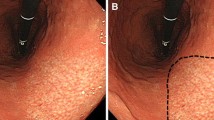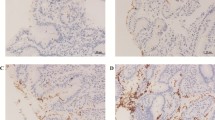Abstract
The purpose of this study was to determine whether Helicobacter pylori infection and mucosal inflammation result in gastric atrophy in Japanese children. A total of 196 patients ages 1–16 years were retrospectively studied: 131 patients were infected with H. pylori and 65 patients were uninfected. Antral (n = 196) and corpus biopsy specimens (n = 70) were investigated based on the Updated Sydney system. In both the antrum and corpus, H. pylori-infected patients showed significantly higher degrees of inflammation and activity of gastritis, compared with noninfected patients. The prevalence of grade 2 or 3 atrophy in the antrum was 10.7% in H. pylori-infected patients and 0% in the noninfected patients (P < .01) and in corpus 4.3% and 0%, respectively (P = .20). The frequency of intestinal metaplasia in the 2 study groups was 4.6% and 4.6% in the antrum and 0% and 4.2% in the corpus, respectively. Among H. pylori-infected patients, the antrum showed significantly higher degrees of H. pylori density, inflammation and activity of gastritis, and atrophy than the corpus. In the antrum, atrophy was significantly correlated with activity, whereas in the corpus, atrophy correlated with H. pylori density, inflammation, and activity. H. pylori-induced gastric inflammation can cause atrophy in Japanese children, predominantly in the antrum. It remains to be determined whether H. pylori-infected children with gastric atrophy are at increased risk for gastric cancer.
Similar content being viewed by others
References
Suerbaum S, Michetti P: Helicobacter pylori infection. N Engl J Med 347:1175–1186, 2002
Kato S, Sherman PM: What is new related to Helicobacter pylori infection in children and teenagers? Arch Pediatr Adolesc Med 159:415–421, 2005
Drumm B, Sherman P, Cutz E, Karmali M: Association of Campylobacter pylori on the gastric mucosa with antral gastritis in children. N Engl J Med 316:1557–1561, 1987
Macarthur C, Saunders N, Feldman W: Helicobacter pylori, gastroduodenal disease, and recurrent abdominal pain in children. JAMA 273:729–734, 1995
Kato S, Nishino Y, Ozawa K, et al.: The prevalence of Helicobacter pylori in Japanese children with gastritis or peptic ulcer disease. J Gastroenterol 39:734–738, 2004
Sherman PM: Peptic ulcer disease in children: diagnosis, treatment, and the implication of Helicobacter pylori. Gastroenterol Clin North Am 23:707–725, 1994
Louw JA, Falck V, van Rensberg C, Zak J, Adams G, Marks IN: Distribution of Helicobacter pylori colonization and associated gastric inflammatory changes: difference between patients with duodenal and gastric ulcers. J Clin Pathol 46:754–756, 1993
Meining A, Stolte M, Hatz R, et al.: Differing degree and distribution of gastritis in Helicobacter pylori-associated diseases. Virchow Arch 431:11–15, 1997
Genta RM, Hamner HW, Graham DY: Gastric lymphoid follicles in Helicobacter pylori infection: frequency, distribution, and response to triple therapy. Hum Pathol 24:577–583, 1993
Kuipers EJ, Uyterlinde AM, Pena AS, et al.: Long-term sequelae of Helicobacter pylori gastritis. Lancet 345:1525–1528, 1995
Correa P: Human gastric carcinogenesis: a multistep and multifactorial process. Cancer Res 48:6735–6740, 1992
Banatvals N, Mayo K, Megraud F, Jennings R, Deeks JJ, Feldman RA: The cohort effect and Helicobacter pylori. J Infect Dis 168:219–221, 1993
Blaser MJ, Chyou PH, Nomura A: Age at establishment of Helicobacter pylori infection and gastric carcinoma, gastric ulcer, and duodenal ulcer risk. Cancer Res 55:562–565, 1995
Meining A, Behrens R, Lehn N, Bayerdorffer E, Stolte M: Different expression of Helicobacter pylori gastritis in children: evidence for a specific pediatric disease? Helicobacter 1:92–97, 1996
Whitney AE, Gaurner J, Hutwagner L, Gold BD: Helicobacter pylori gastritis in children and adults: comparative histopathologic study. Ann Diagn Pathol 4:279–285, 2000
Guarner J, Bartlett J, Whistler T, et al.: Can pre-neoplastic lesions be detected in gastric biopsies of children with Helicobacter pylori infection? J Pediatr Gastroenterol Nutr 37:309–314, 2003
Joossens JV, Geboers J: Diet and environment in the etiology of gastric cancer. In Frontiers in gastrointestinal cancer. Levin B, Riddell RH (eds). New York, Elsevier, 1984, pp 167–183
Asaka M, Kimura T, Kudo M, et al.: Relationship of Helicobacter pylori to serum pepsinogens in an asymptomatic Japanese population. Gastroenterology 102:760–766, 1992
Uemura N, Okamoto S, Yamamoto S, et al.: Helicobacter pylori infection and the development of gastric cancer. N Engl J Med 345:784–789, 2001
Kato S, Ozawa K, Konno M, et al.: Diagnostic accuracy of the 13C-urea breath test for childhood Helicobacter pylori infection: a multicenter Japanese study. Am J Gastroenterol 97:1668–1673, 2002
Genta RM, Graham DY: Comparison of biopsy sites for the histopathologic diagnosis of Helicobacter pylori: a topographic study of H. pylori density and distribution. Gastrointest Endosc 40:342–345, 1994
Dixon MF, Genta RM, Yardley JH, Correa P: Classification and grading of gastritis. The updated Sydney System. Am J Surg Pathol 20:1161–1181, 1996
Campbell DI, Warren BF, Thomas JE, Figura N, Telford JL, Sullivan PB: The African enigma: low prevalence of gastric atrophy, high prevalence of chronic inflammation in West African adults and children. Helicobacter 6:263–267, 2001
Guiraldes E, Pena A, Duarte I, et al.: Nature and extent of gastric lesions in symptomatic Chilean children with Helicobacter pylori-associated gastritis. Acta Paediatr 91:39–44, 2002
De Giacomo C, Fiocca R, Villani L, et al.: Helicobacter pylori infection and chronic gastritis: clinical, serological, and histologic correlations in children treated with amoxicillin and colloidal bismuth subcitrate. J Pediatr Gastroenterol Nutr 11:310–316, 1990
Kato S, Takeyama J, Ebina K, Naganuma H: Omeprazole-based dual and triple regimens for Helicobacter pylori eradication in children. Pediatrics 100:e3, 1997
Sipponen P: Gastric cancer: a long-term consequence of Helicobacter pylori infection? Scand J Gastroenterol 29(Suppl 201):24–27, 1994
Rugge M, Correa P, Dixon MF, et al.: Gastric mucosal atrophy: interobserver consistency using new criteria for classification and grading. Aliment Pharmacol Ther 16:1249–1259, 2002
Genta RM: Recognizing atrophy: another step toward a classification of gastritis. Am J Surg Pathol 20(Suppl 1):23–30, 1996
Bozzola C, Boldorini R, Guidali P, Paracchini R, Rapa A, Oderda G: Mild infiltration in childhood Helicobacter pylori gastritis: a morphometric and morphologic analysis (abstract). Gut 51(Suppl II):A82, 2002
Cohen MC, Cueto R, Balcarce N, Donatone J, Drut R: Assessment of the Sydney System in Helicobacter pylori-associated gastritis in children. Acta Gastroenterol Latinoam 30:35–40, 2000
Usta Y, Saltik-Temizel IN, Ozen H: Gastric atrophy and intestinal metaplasia in Helicobacter pylori infection (letter). J Pediatr Gastroenterol Nutr 38;548, 2004
Jones NL, Shannon PT, Cutz E, Yeger H, Sherman PM: Increase in proliferation and apoptosis of gastric epithelial cells early in the natural history of Helicobacter pylori infection. Am J Pathol 151:1695–1703, 1997
Ozawa K, Kato S, Sekine H, et al.: Gastric epithelial cell turnover and mucosal protection in Japanese children with Helicobacter pylori infection. J Gastroenterol 40:236–246, 2005
Drumm B, Day AS, Gold B, et al.: Helicobacter pylori and peptic ulcer: working group report of the second World Congress of Pediatric Gastroenterology, Hepatology, and Nutrition. J Pediatr Gastroenterol Nutr 39:S626–S631, 2004
Author information
Authors and Affiliations
Corresponding author
Rights and permissions
About this article
Cite this article
Kato, S., Nakajima, S., Nishino, Y. et al. Association Between Gastric Atrophy and Helicobacter pylori Infection in Japanese Children: A Retrospective Multicenter Study. Dig Dis Sci 51, 99–104 (2006). https://doi.org/10.1007/s10620-006-3091-5
Received:
Accepted:
Issue Date:
DOI: https://doi.org/10.1007/s10620-006-3091-5




